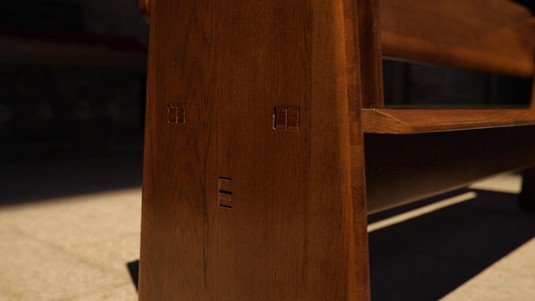An EPFL lab designs new wooden pews for the Lausanne Cathedral
The Canton of Vaud has selected a technology developed by EPFL's IBOIS Laboratory for the construction of new pews for Lausanne’s Cathedral of Notre Dame. The pews, built with locally-sourced wood, have an innovative design that does not require either glue or screws.
On Thursday, the Canton of Vaud announced that the chairs in the Lausanne Cathedral will soon be replaced by wooden pews crafted using a technique developed by EPFL’s IBOIS Laboratory for Timber Constructions. Both the lab and EPFL have signed a technology transfer agreement with the Canton.
The pews, made from oak panels, will be assembled using a joinery technique known as snap-fit. IBOIS, which is headed by associate professor Yves Weinand, first introduced this technique at the international ACADIA conference in Los Angeles in 2014. In all, 74 six-seat pews measuring 300 cm each and 4 four-seat pews measuring 200 cm each will be created. The Canton of Vaud hopes to inaugurate the pews, which can accommodate up to 460 people, in time for Easter 2022.
Easy to dismantle and reassemble
The three-ply oak panels, varying in thickness between 20 and 26 mm, are uniform in appearance and very robust. A computer numerical control (CNC) wood router, with an accuracy of 0.01 mm, will be used to mill the parts. The wood will be sourced from Canton-owned forests in Concise, Etagnières and Cossonay, thus promoting local manufacture and short supply chains.
The new pews will be placed in the Cathedral’s nave and transepts, replacing the rush-seated chairs that date from 1912. They are designed to be easily dismantled and reassembled, allowing them to be moved or stored flat, thus reducing transport and storage space. Each pew, consisting of 14 planks and two wooden or metal dowels, can be put together by two people in less than 15 minutes with a simple wooden mallet.
Flexibility of use
At the Canton’s request, the pews will also be fitted with reversible backs, providing added flexibility for events such as organ concerts, official ceremonies and religious services. The backs are attached to the armrests, and a wooden peg enables them to be shifted from one side to the other in a single movement, without the use of tools. Shock absorbers prevent the backrest from banging when reversed. The seat's symmetry provides the same level of comfort regardless of which side is used, and the design makes the pews easy to maintain.
Working from the prototype developed by Yves Weinand and IBOIS, several woodworking companies responded to the call for tenders issued in January 2020. Bidders, complying with the specifications, used snap-fit joints in accordance with the instructions provided. The winner, GAB Manufacture SA, reworked the model in collaboration with designer Thierry Didot, producing a pew with an elegant, streamlined appearance.
November 2018 – an early prototype
In August 2019, the IBOIS Laboratory received the go-ahead to develop the Cathedral's pews. This was not, however, its first experience with the snap-fit technique. In November 2018, the lab designed risers and benches for performances of the opera Nabucco that were held in the Cathedral. The seats, milled from panels of oriented strand board (OSB), could be dismantled and reassembled (see related article). Weinand's initial design for the new pews thus replicated the formal aspect and mechanical properties of the chipboard benches created for Nabucco.
With some 475,000 visitors in 2019, the Lausanne Cathedral is one of the country's most popular historical monuments. This project will highlight IBOIS's research and its commitment to promoting the use of wood in construction through technology transfer.










Project's authors: Yves Weinand and Thierry Didot
Technology transfer: IBOIS Laboratory for Timber Constructions
IBOIS team members: Yves Weinand (director), Martin Nakad (scientific assistant) and François Perrin (technician)
Architect: Yves Weinand Architectes Sàrl
Woodworking company: GAB Manufacture SA
Project owner: Canton of Vaud
Origin of wood: Vaud Canton, Switzerland















